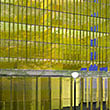Woodscrapers
Woodscrapers
The first skyscrapers rose on masonry support walls. Then came steel frames and, soon after, glass facades. So what’s the next big thing in tall buildings? Titanium? Skyhooks? How about: Wood!
Tall wooden buildings – called “woodscrapers” or “plyscrapers,” depending on your preference – have been rising in Europe and Canada, and could soon come to U.S. skylines.
Unlike the wooden building construction of old, in which long beams were cut from tall trees, these buildings rely on super-strong, engineered beams and panels called cross-laminated timber (CLT) – a kind of plywood on steroids. To make CLT, thin cross-sections of wood are layered with glue in a special cross-configuration that gives it dramatically increased strength, rigidity, and load-bearing capability.
In Vancouver, British Colombia, architect Michael Green proposed a 30-story wooden high-rise tower using this new wood technology. Should he get the go-ahead, the project won’t be short of building materials. Massive expanses of pine forest nearby have died off due to a beetle infestation, leaving two billion trees in its wake. This unexpected problem of “too much wood” has been answered by a governmental edict requiring builders to consider wood for new construction.
Even in areas where there is not an unexpected wood glut, experts say that, properly managed, wood can be a sustainable and renewable building material.






